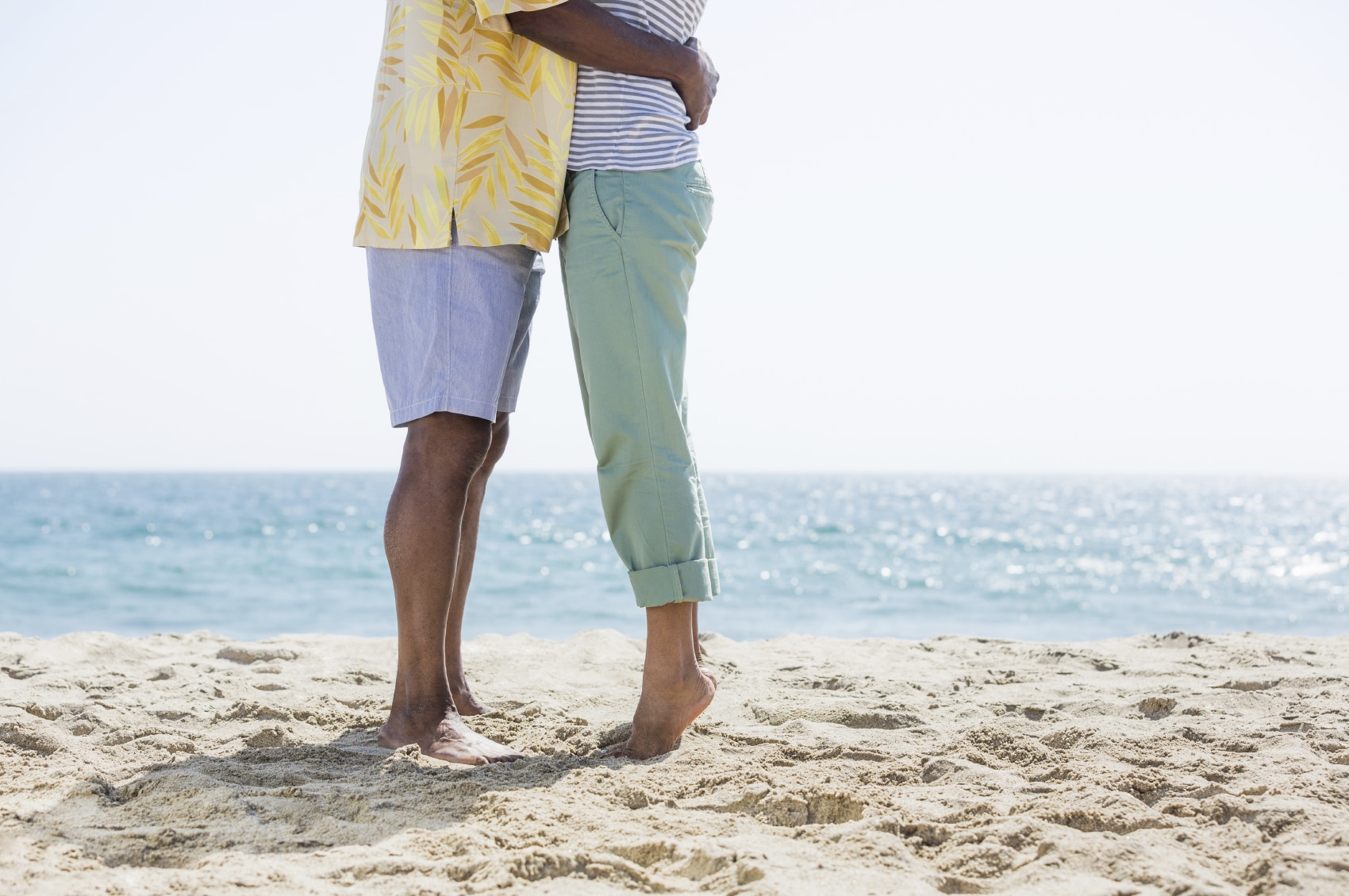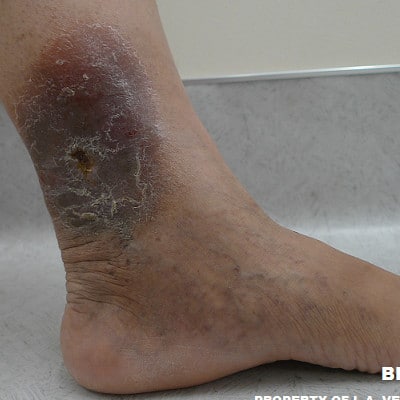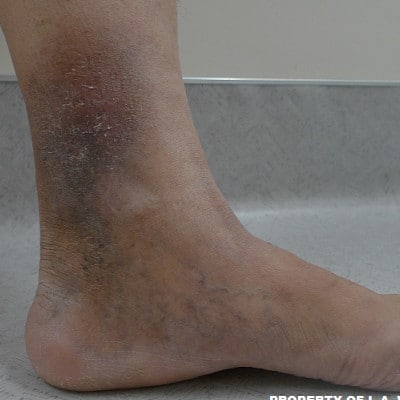What are Leg Ulcers?
Leg ulcers can be caused by inadequate blood flow from the arteries or the veins. Inadequate treatment or improper diagnosis could potentially lead to loss of limb. Because of this, the best person to evaluate a leg ulcer is a vascular surgeon such as Dr. Lee who can treat both arteries and veins. Call (818) 325-0400 today to schedule your leg ulcer consultation with Dr. Lee!

Venous Skin Ulcer (Stasis Leg Ulcer)
Aside from causing complications with blood flow, conditions of the vascular system can also affect the skin and other systems of the body. Also known as a stasis leg ulcer, a venous skin ulcer is a wound or opens a sore that appears on the skin when the leg veins do not carry blood back to the heart, a condition known as venous insufficiency. Venous skin ulcers develop on the lower leg as a complication of long-term untreated venous insufficiency and can cause pain, odor, pus, tenderness, and redness. This condition can often be prevented by treating venous insufficiency before venous ulceration occurs.
Venous skin ulcers develop on the skin after the blood vessels in the leg and the surrounding tissue breaks down, leaving a visible wound on the skin. These ulcers are often found above the ankle and below the calf. The skin in the affected area may initially appear dark brown, red, or purple and may feel thickened, dry, and itchy. Ulcers can eventually develop from this abnormal skin if left alone.
VENOUS ULCER Before & After


What happens if Leg Ulcers go untreated?
Patients with untreated venous insufficiency have an increased risk of ulcers forming in areas where blood is building up. In particular, patients who have had deep vein thrombosis and post-thrombotic syndrome are more prone to developing venous ulcers. If left untreated, these wounds may become chronic and seemingly incurable. It is important to treat ulcers as soon as they appear to help facilitate the healing process and prevent infection.
Leg Ulcer treatment in Los Angeles, CA
A venous ulcer can be treated by a multi-modality approach. First, the adequate arterial blood supply to heal the ulcer is mandatory. Next, superficial venous insufficiency can be treated with minimally invasive radiofrequency catheter ablation of the abnormal vein causing pooling of blood in the leg. Some people with post-thrombotic syndrome after deep vein thrombosis, have blockages in their deep pelvic veins. These blockages can be opened up with stents during a venogram procedure using intravascular ultrasound in the angiosuite. In addition, the wounds may need daily or weekly wound care and compression therapy until they heal. Dr. Lee’s extensive experience and training in both arterial and venous disease can help diagnose your condition and determine the best treatment option for you.
Patient Testimonial…
"My experience has been critical to settling my doubts and continuing fears that my previous procedures were incomplete. Dr. Lee and her staff are thorough, great at explaining things and give important follow up instructions after you leave. I am grateful for all they did and trust Dr. Lee for her diagnosis and laying out what the path ahead that entails for what you need to be aware if. She is the best."
What is radiofrequency catheter ablation for leg veins?
You may have heard of endovenous radiofrequency ablation used to treat varicose veins. This uses thermal energy to damage the vein. The same is true with radiofrequency (RF) ablation, but Dr. Lee feels that our L.A. Vein Center patients have less discomfort with RF ablation.
The procedure involves the insertion of a radiofrequency fiber into the abnormal vein. The RF energy converts to heat damages the vein walls and causes sclerosis (closing off) of the vein. The procedure is very successful with minimal discomfort afterward.
The Radiofrequency Ablation Procedure
Dr. Lee performs these minimally invasive procedures in our state-of-the-art L.A. Vein Center facility. Here’s how the procedure is done. After applying local anesthetic at the site of the initial catheter insertion, the procedure involves five steps:
- Using ultrasound guidance to locate the vein, Dr. Lee inserts a thin RF fiber through a tiny entry point, usually near the knee. The RF fiber is advanced to where the treatment will begin.
- Next, a local anesthetic is applied along the length of the vein. This enhances patient comfort and improves contact between the RF fiber and the vein wall.
- The RF fiber has a 7-centimeter-long active tip. It releases the RF energy along this 7-centimeter length for a period of only 20-40 seconds.
- The radiofrequency energy released from the tip produces a thermal reaction in the vein wall along the 7 centimeters, causing the wall to collapse and the vein to close off.
- The RF fiber is then pulled back to the next section and the process is repeated until the length of the vein is treated.
Results of RF Ablation for Leg Veins
These are highly successful procedures, while still being only minimally invasive. Research has shown that radiofrequency ablation has success rates of around 95 percent. This procedure also has far fewer complications compared with vein stripping surgery. After closing off the troublesome vein, the patient will need to continue to be diligent about caring for the ulcerated skin.
What happens after my Leg Ulcer treatment?
After your radiofrequency catheter ablation, Dr. Lee will put you in compression stockings. This compression hosiery helps ensure the vein stays closed and the compression jumpstarts the process of the body eventually absorbing the now-unused vein. You’ll wear your stockings overnight for the first night. After that, you’ll wear them during the day for at least two weeks.
Before you leave our Sherman Oaks offices, you’ll be directed to take a 20-30-minute walk. Then, depending on the degree of ulceration on your leg, you can drive home. From there, walking at least 30 minutes each day is mandatory.
Is there downtime after a Leg Ulcer treatment?
You can return to normal activities immediately but should avoid standing still for long periods, and you’ll need to avoid long-haul flights for at least 3-4 weeks.
Dr. Lee will have you return for an ultrasound check of your treated vein two weeks after your treatment.
Is radiofrequency ablation safe?
These treatments with Dr. Lee are safe and effective. Vein stripping used to be the go-to method for treating leg vein problems, and when you compare radiofrequency ablation with that procedure there really isn’t any comparison. Also, radiofrequency ablation energy uses lower temperatures than laser endovenous ablation, so patients are more comfortable. It’s a great treatment for problematic leg veins with success rates of over 95 percent for closing off and removing the vein.
Read what our patients are saying!
"I have been a patient of Dr. Lee since April 2012. At that time, I had experienced a strange swelling in my left leg which turned out to be a blood clot, and Dr. Lee has been treating me since then. I am happy to say, less than one year later, my leg is almost back to normal because of Dr. Lee’s clear guidance, expertise, professionalism, and kindness. I am very glad to have had Dr. Lee by my side during this difficult time."
Risks of Radiofrequency Ablation of Leg Veins
Complications are very rare with radiofrequency ablation. There is a possibility of deep vein thrombosis/clotting. Nerve damage to surface sensory veins is possible, but these nerves usually return to normal in a few weeks to months.
Consult Dr. Lee For Leg Ulcer Treatment in Sherman Oaks, CA!
Interested in learning more about radiofrequency ablation and whether you are a candidate for leg ulcer treatment? Give us a call at (818) 325-0400 today or fill out the form in our contact page. Dr. Larisse Lee looks forward to serving you!
Contact our Los Angeles office to learn more about Leg Ulcers, or to make an appointment.

